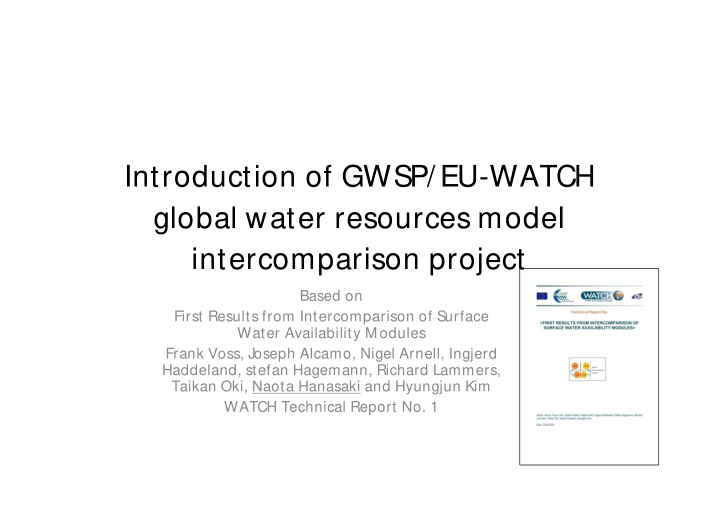



Introduction of GWSP/ EU-WATCH global water resources model intercomparison project Based on First Results from Intercomparison of Surface Water Availability M odules Frank Voss, Joseph Alcamo, Nigel Arnell, Ingjerd Haddeland, stefan Hagemann, Richard Lammers, Taikan Oki, Naota Hanasaki and Hyungjun Kim WATCH Technical Report No. 1
Background • Climate change impact projections have extensively compiled into the IPCC reports. • Although, the simulation settings of them varies one by one, even in global studies. Climate scenario Social/ Land cover scenario M odel Projection Other simulation settings • Global hydrological modeling community launched a model intercomparison program. • H08 (NIES/ UT) is participating this program.
Project History Prof Joseph Alcamo proposed a model intercomparison program 2006/ 4 under GWSP (http:/ / www.gwsp.org/ ) An academic research project EU-WATCH started 2007/ 2 (http:/ / www.eu-watch.org/ ) Workshop in Kassel (Germany), 1 st round started 2007/ 4 1 st round submission deadline Report available 2007/ 7 Workshop in Wageningen (The Netherlands), 2 nd round started 2008/ 4 2 nd round submission deadline 2008/ 8 Workshop in Bratislava (Slovakia), 3 rd round started 2008/ 11 3 rd round submission deadline 2009/ 4
Who participated in the 1 st round? M odel Institute Reference 1. WaterGAP University of Kassel Alcamo et al. 2003 University of Frankfurt Döll et al. 2003 2. M ATSIRO University of Tokyo Takata et al. 2003 3. H07 NIES Hanasaki et al. 2007a Hanasaki et al. 2007b 4. M acPDM University of Reading Arnell, 2003 5. SL scheme/ HD model M ax Planck Institute Hagemann & Dmenil Gates 2003 [M PI-HM ] for M eteorology M PI-M Hagemann & Dmenil 1998 6. WBM plus University of New Hampshire Vorsmarty et al. 2000 7. VIC VIC community Nijssen et al. 2001 The number of participants doubled in the 2 nd round (Nov, 2008).
Key results of the 1 st round Global total river discharge (A1B, 2090s) Baseline Average WaterGAP H07 M PI VIC M ATSIRO M acPDM WBM Plus
Current status and Future direction • Current status of the model intercomparison project – Simulation protocol (description of common simulation settings) is getting more strict. – Common baseline and future climate scenario are getting more sophisticated. – Participants are increasing • Problems – Heavy load for both organizers and participants – Scientific goal? • Implication – M ulti-model ensemble impact assessment in AR5?
Recommend
More recommend